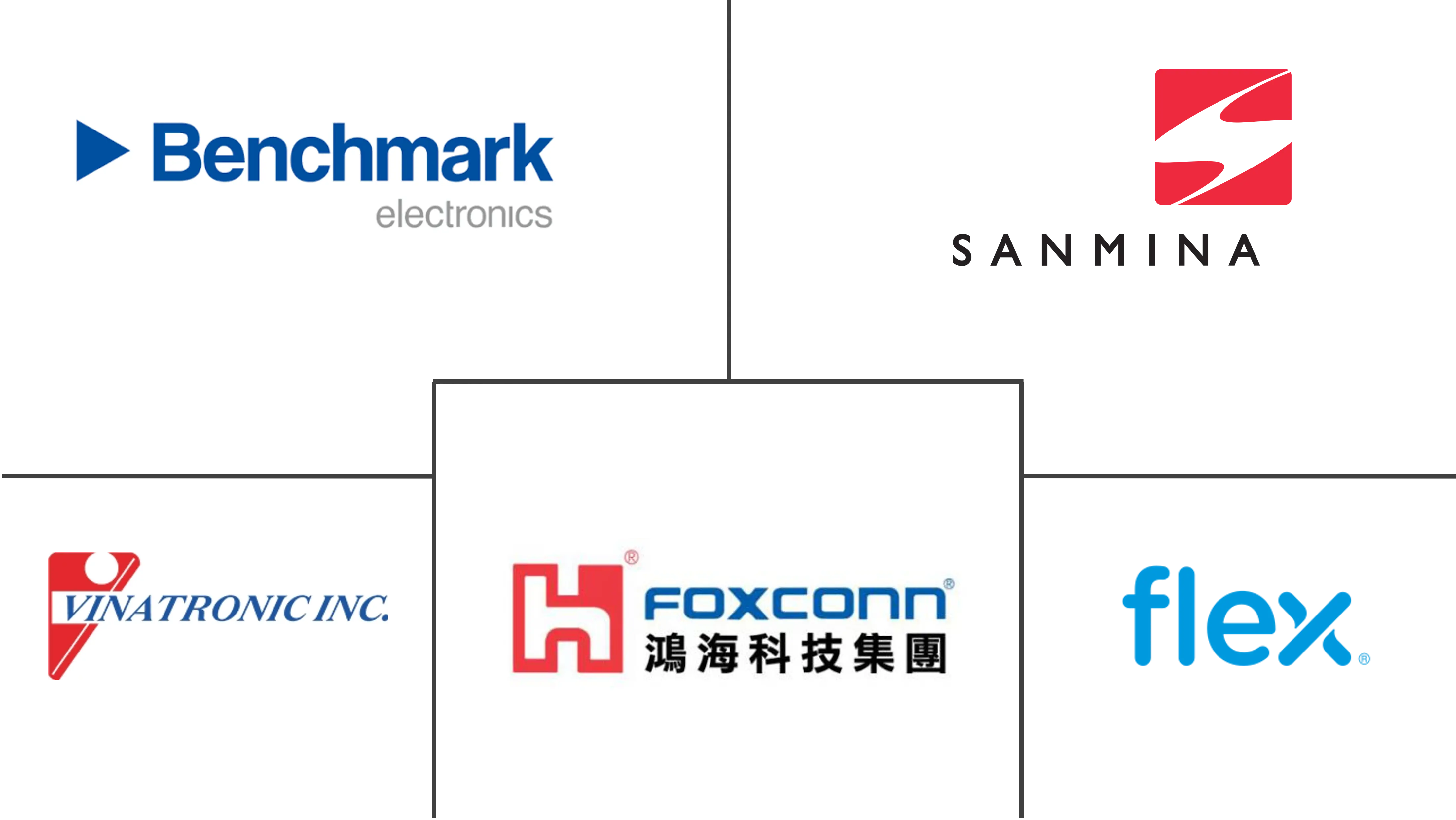Electronics Manufacturing Services Market Size and Share
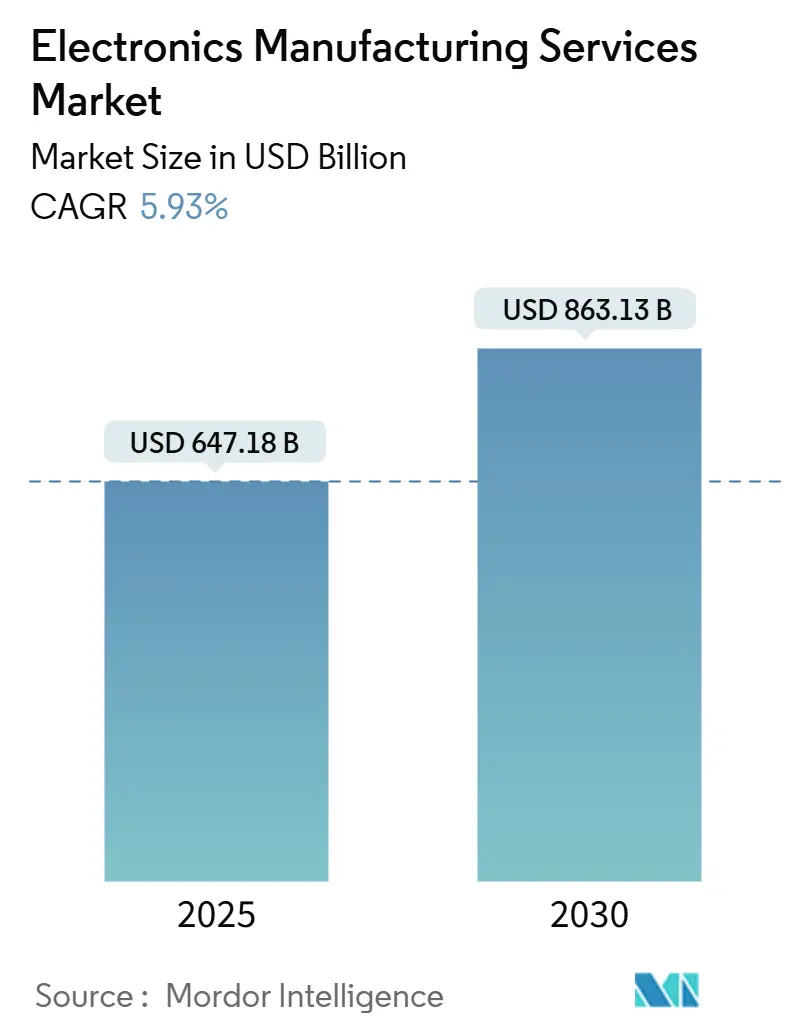
Electronics Manufacturing Services Market Analysis by Mordor Intelligence
The electronic manufacturing services market size stood at USD 647.18 billion in 2025 and is forecast to expand to USD 863.13 billion by 2030 at a 5.93% CAGR. The growth trajectory reflects OEMs’ ongoing preference for outsourcing to focus on R&D while accessing cutting-edge assembly capabilities. Demand for AI infrastructure equipment, the rapid electrification of vehicles, and a wave of supply-chain reshoring from China to diversified regional hubs are the most visible accelerants. Regulatory costs tied to IEC 60601 and RoHS III, volatile semiconductor pricing, and mounting cybersecurity requirements have pushed providers to consolidate and invest in compliance-ready plants. Meanwhile, smart-factory investments in digital MES platforms sharpen productivity and offer differentiation in high-mix, low-volume programs.[1]GE Vernova, “The Technology Behind General Motors' MES 4.0,” gevernova.com
Key Report Takeaways
- By service type, PCB assembly and box-build held 62.4% of the electronic manufacturing services market share in 2024, while after-market services are on track for an 8.4% CAGR through 2030.
- By business model, contract manufacturing captured 71.5% revenue share in 2024; original design manufacturing is projected to grow at 9.1% CAGR.
- By manufacturing process, surface-mount technology led with 78.5% share in 2024, whereas advanced packaging is set to rise at 10.3% CAGR.
- By end-use industry, mobile devices generated 66.5% demand share in 2024, yet automotive and EV electronics are forecast to climb at a 12.3% CAGR.
- By geography, Asia-Pacific accounted for 47.3% revenue share in 2024 and is advancing at a 13.1% CAGR to 2030.
Global Electronics Manufacturing Services Market Trends and Insights
Drivers Impact Analysis
| Driver | (~) % Impact on CAGR Forecast | Geographic Relevance | Impact Timeline |
|---|---|---|---|
| OEMs Outsourcing to Focus on Core Competencies and Reduce Capex in High-Mix Low-Volume Segments in North America and Europe | +1.2% | North America and Europe | Medium term (2-4 years) |
| Accelerated Near-/Re-shoring of Supply Chains to Mexico, Eastern Europe and ASEAN Post-China Tariffs | +0.8% | Global, with concentration in Mexico, Eastern Europe, ASEAN | Short term (≤ 2 years) |
| Surge in EV Power-Electronics Requiring Advanced PCB Assembly Capabilities | +1.5% | Global, led by China, Europe, North America | Medium term (2-4 years) |
| Proliferation of IIoT Edge Devices Driving HDI and Advanced Packaging EMS Demand in Asia | +0.9% | Asia-Pacific core, spill-over to global | Long term (≥ 4 years) |
| Stringent IEC 60601 and FDA 21 CFR 820 Quality Norms Lifting Certified Healthcare EMS Outsourcing | +0.6% | Global, with emphasis on the US and the EU | Medium term (2-4 years) |
| Rapid-Cycle Consumer Device Launches Boosting Flexible NPI and DfM Service Needs | +0.7% | Global, concentrated in Asia-Pacific | Short term (≤ 2 years) |
| Source: Mordor Intelligence | |||
OEMs Outsourcing to Focus on Core Competencies
Capital-intensive tooling for high-mix, low-volume programs pushed many North American and European OEMs to rely on EMS partners prior to 2025. General Motors’ MES 4.0 roll-out illustrated how digital integration improved shop-floor visibility while external partners handled complex assemblies. Outsourcing lets brand owners redirect spending toward design, software, and go-to-market work. Providers benefited by offering flexible lines that could switch from an industrial controller build to a short-run medical device without retooling. Over 2024–2025, demand for turnkey programs rose sharply in consumer electronics, where six-month refresh cycles require rapid iteration. This driver is poised to keep transaction volumes high through 2027 as product complexity grows and in-house lines struggle to keep pace.
Accelerated Near-/Re-shoring of Supply Chains
Tariff uncertainty and pandemic-era logistics disruptions triggered a fast relocation of PCB and box-build capacity toward Mexico, Eastern Europe, and ASEAN in 2024. Foxconn’s USD 383 million board plant in Vietnam typified the movement away from single-country dependence. Mexico leveraged USMCA to secure automotive and server rack programs for the United States, while Poland and Romania targeted European EV platforms. Localization reduced freight lead times by up to 40% and lowered inventory risk. Small-batch manufacturers adopted the same strategy to keep custom builds closer to end customers. The trend remains strongest in 2025 as inflationary freight rates and geopolitical tensions sustain the need for diversified footprints.
Surge in EV Power-Electronics Requirements
Wider adoption of 800-volt drivetrains and silicon-carbide inverters elevated PCB layer counts, demanding fine-line and heavy-copper capabilities seldom available in legacy auto plants. Renesas’ 100 kW xEV inverter reference design, published in 2023, demonstrated the complexity of new power stages that EMS firms must master. Providers that invested early in selective solder, vacuum reflow, and advanced conformal-coat lines secured multi-year contracts with tier-1 suppliers. In 2025, automotive OEMs specified tighter traceability and ISO 26262 compliance, increasing the value per board and lengthening engagement terms. The driver will keep margins above corporate averages through 2030 as demand for traction inverters and battery management boards rises in line with EV adoption.
Proliferation of IIoT Edge Devices
High-density interconnect (HDI) boards and system-in-package solutions became central to IIoT deployments, especially for rugged edge gateways combining AI inference with real-time control. Advantech’s EdgeLink suite highlighted the need for durable designs that operate in harsh factories while exchanging large data streams. Asian EMS hubs leveraged existing semiconductor back-end talent to offer fan-out wafer-level and embedded die packaging. As 5G coverage widened, demand for compact edge servers grew and required tight component placement and improved thermal paths. The transition is expected to intensify between 2026 and 2029, reinforcing Asia-Pacific’s contribution to technology-rich builds.
Restraints Impact Analysis
| Restraint | (~) % Impact on CAGR Forecast | Geographic Relevance | Impact Timeline |
|---|---|---|---|
| Rising Semiconductor and Passive Component Cost Volatility Compressing EMS Margins | -0.9% | Global | Short term (≤ 2 years) |
| IP Protection Concerns Limiting Outsourcing in EU Aerospace and Defense | -0.4% | Europe, with spillover to North America | Long term (≥ 4 years) |
| Competition From ODMs and OEM In-house Lines in Smartphones | -0.6% | Global, concentrated in Asia-Pacific | Medium term (2-4 years) |
| RoHS III and REACH Compliance Raising Capex for Legacy Facilities | -0.3% | Europe, with global implications | Medium term (2-4 years) |
| Source: Mordor Intelligence | |||
Rising Semiconductor and Passive Component Cost Volatility
Memory and power devices swung in price by double-digit percentages during 2024, leaving EMS firms exposed when customer contracts locked BOM prices for quarters in advance. Supplyframe data showed that 75% of components either stabilized or declined, yet high-bandwidth memory faced acute shortages, straining AI server builds.[2]Supply Chain Dive Editors, “Supplyframe Commodity IQ Points to Favorable Procurement Conditions,” sdcexec.com Large providers prepaid chipmakers or hedged with consignment deals, but small firms absorbed margin pressure. Higher obsolescence made inventory buffers riskier, prompting consolidation as scale became critical to weather volatility. Although prices moderated in early-2025, strategic sourcing complexity remains a drag on earnings.
IP Protection Concerns in Aerospace and Defense
European regulators tightened cybersecurity mandates for flight-critical electronics after 2024, spotlighting data-integrity risks in outsourced manufacturing. The AIDA project underscored how autonomous defense systems required secure build environments that many generalist plants could not provide. Programs governed by ITAR and similar EU rules increasingly specify on-shore, restricted-access lines. EMS suppliers responded by ring-fencing aerospace cells and adding CMMC certification, yet capital recovery timelines slowed uptake. These hurdles dampen outsourcing growth in defense and high-security satellite payloads through the decade.
Segment Analysis
By Service Type: Lifecycle Strategies Elevate After-Market Programs
PCB assembly and box-build services contributed 62.4% of the electronic manufacturing services market revenue. Growing preference for closed-loop sustainability drove after-market services toward an 8.4% CAGR, outpacing the broader electronic manufacturing services market. Providers expanded repair hubs on every major continent to cut turnaround times and lower e-waste. Electronics design and engineering engagements intensified as OEMs sought concurrent-engineering savings. Prototype and NPI lines handled shorter lots but yielded high margins by helping brands cut weeks from first-article schedules. Testing and certification labs are integrating cybersecurity assessments alongside electrical safety to meet new regulatory checklists.
In 2025, circular-economy directives in the EU made component harvest and refurbishment viable revenue streams. Leading EMS operators embedded digital twins to predict board-level failures and pre-stage spares. As hardware subscription models spread in industrial automation and consumer devices, post-sale services will become central to contract renewals. Competitive differentiation will hinge on global depot density and data-driven failure analytics.
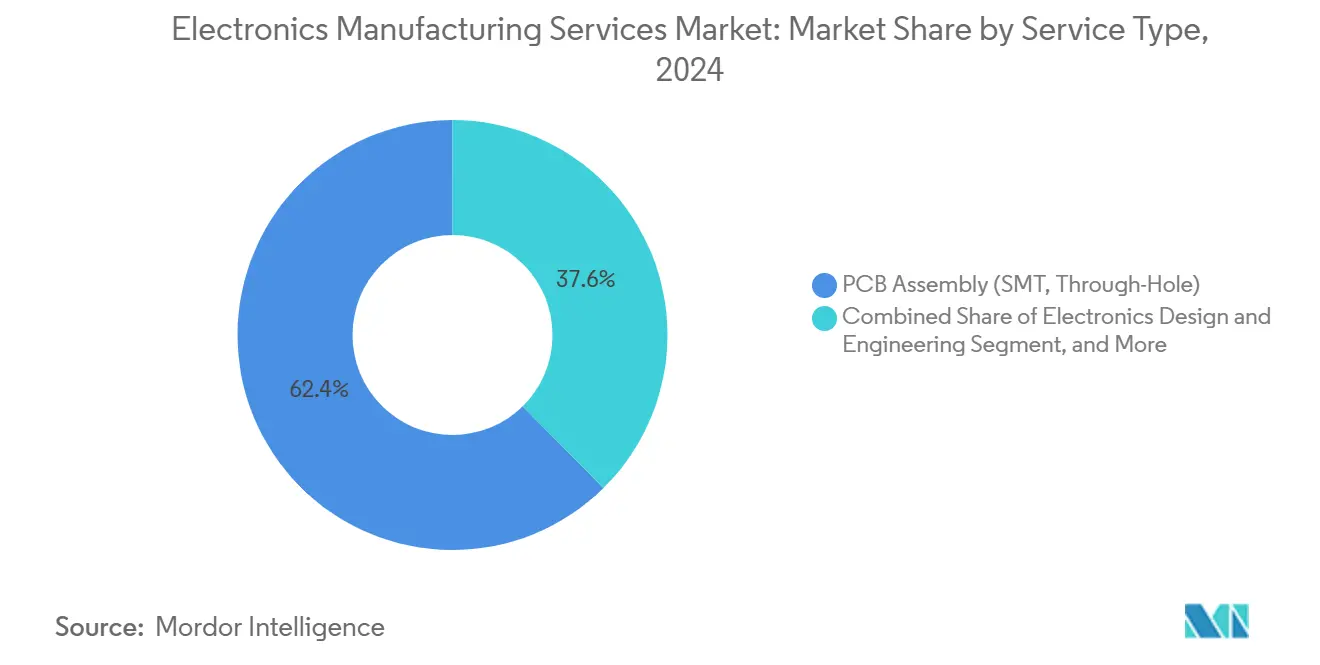
By Business Model: ODM Growth Redraws Relationship Maps
Contract manufacturing remained the bedrock, representing 71.5% of 2024 revenue, yet original design manufacturing grew faster as brands chased one-stop solutions. ODM revenue is set to climb 9.1% annually, pulling the electronic manufacturing services market toward hybrid engagements where design, sourcing, and fulfillment reside in one vendor. Turnkey manufacturing gained traction for AI servers and medical devices that demand secure supply chains. Private-label builds filled niche appliance and smart-lighting slots requiring cost leadership over brand differentiation.
Taiwan-based providers blurred lines by offering white-box platforms pre-certified for global markets. Foxconn and Wistron introduced reference designs that customers could brand, accelerating launch timelines. Contract manufacturers that fail to develop at least light design capabilities risk margin compression in a commoditizing assembly landscape.
By Manufacturing Process: Advanced Packaging Reshapes Capex Profiles
Surface-mount technology dominated with 78.5 of % electronic manufacturing services market share in 2024, thanks to its cost efficiency for high-volume boards. However, system-in-package and other advanced packaging flows posted a 10.3% CAGR. AI accelerators and 5G radios needed die stacking, embedded interposers, and copper redistribution layers that only advanced packaging could deliver. Through-hole retained relevance in aerospace harnesses and legacy power modules, where mechanical robustness outweighed density concerns.
By 2025, market leaders earmarked more than USD 12 billion for new advanced-packaging lines, often co-located with wafer bumping facilities. The electronic manufacturing services market size attached to system-in-package lines is estimated to capture a 15% share by 2030. Providers such as ASE offered turnkey chiplet integration that merged multiple dies in a single housing for smartphones and EV inverters.[3]ASE Group, “System in Package,” aseglobal.com Capital-intensive barriers mean laggards will default to subcontracting critical steps, limiting their margin potential.
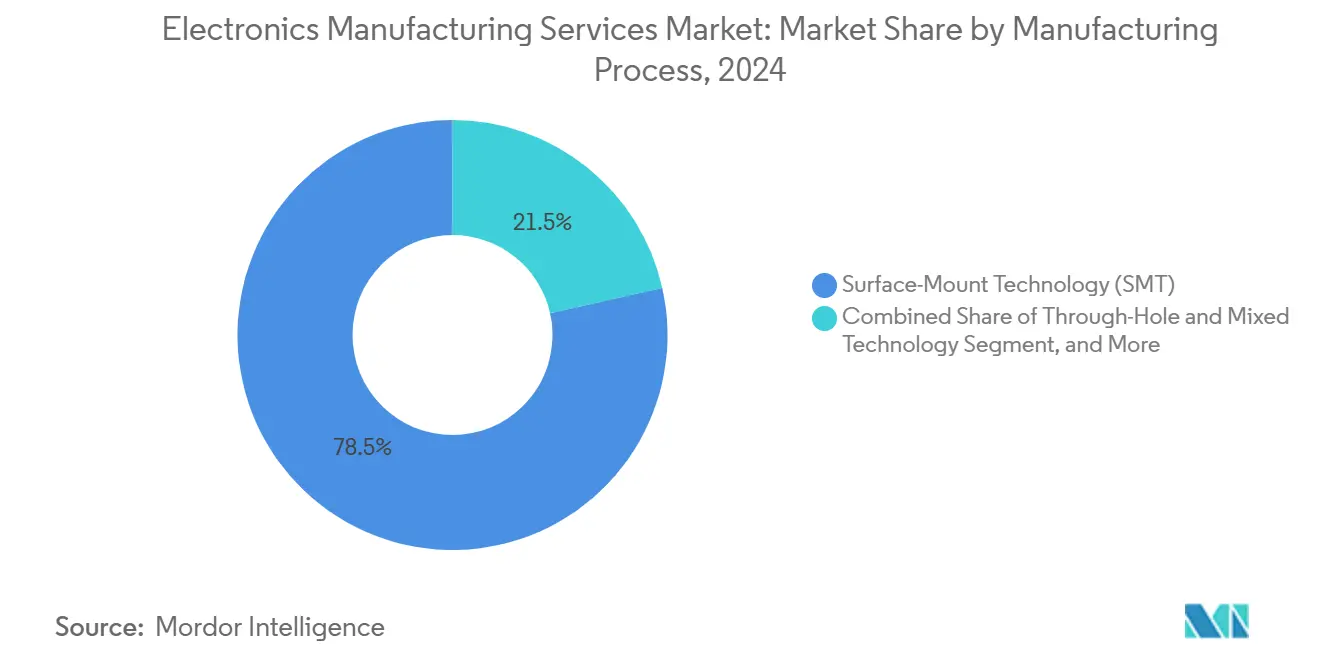
By End-use Industry: Vehicle Electrification Adds High-Value Content
Mobile devices still produced 66.5% of demand in 2024, but handset unit growth slowed. Automotive and EV programs rose at a 12.3% CAGR, reshaping the electronic manufacturing services market as board value per vehicle tripled compared with traditional powertrains. Consumer electronics diversified into wearables and AR headsets. Industrial automation used IIoT gateways and edge AI modules, while healthcare EMS programs benefited from stringent quality gates that supported premium pricing.
Foxconn’s 50% stake in ZF Chassis Modules highlighted auto-tier crossover strategies aimed at USD 9.4 billion annual sales by 2029. Aerospace and defense lines stayed steady yet required AS9100 and IPC J-STD-001 compliance, narrowing supplier pools. IT and telecom segments grew with global data-center rollouts and small-cell 5G installs. Smart-meter rollouts in utilities opened demand for rugged, low-power boards requiring 15-year field life.
Geography Analysis
Asia-Pacific held 47.3% of 2024 revenue and posted a 13.1% CAGR, the highest among regions, as companies diversified into Vietnam, India, and Thailand while retaining China for scale production. Government incentives in India’s PLI scheme drew handset and wearables programs, and Vietnam became a preferred site for high-layer PCBs targeting US buyers. North America enjoyed strong inflows into Mexican industrial corridors, with many EV OEMs demanding localized printed-circuit capacity by 2026. Domestic content rules in defense electronics secured new plant builds in Arizona and Texas. Europe prioritized compliance-heavy medical and industrial programs, leveraging proximity to OEM design centers despite higher labor costs.
South America’s share remained modest yet grew as Brazil and Mexico advanced electronics clusters linked to automotive final assembly. Taiwan’s PCB ecosystem, projected to grow 5.8% yearly through 2025, supplied advanced substrates to global AI server builders. Middle East and Africa saw initial investments in smart metering and renewable energy controllers, often bundled with training initiatives. The electronic manufacturing services market size in emerging regions will broaden as decarbonization projects demand localized electronics content.
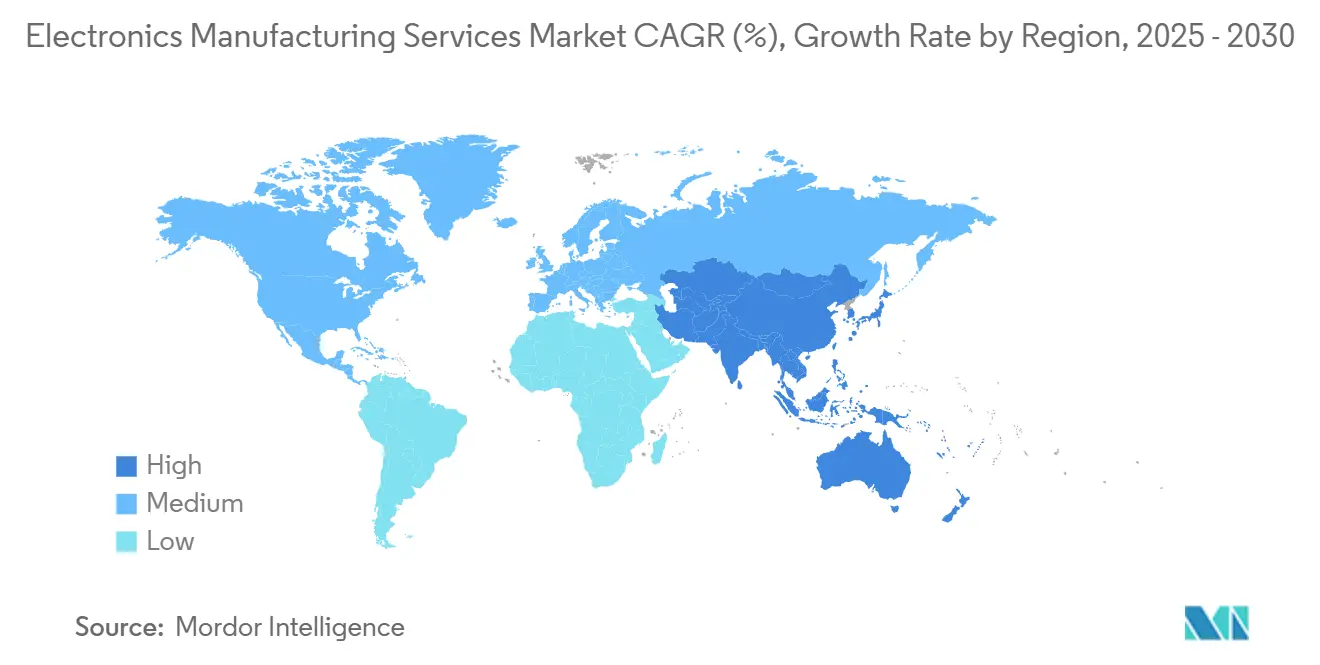
Competitive Landscape
Foxconn, Flex, and Jabil continued to dominate, each deploying AI-driven optical inspections and digital twins to improve first-pass yields. Together, they generated USD 17.4 billion in European sales in 2024. Mid-tier players such as Sanmina pursued scale via acquisitions; the USD 2.55 billion purchase of ZT Systems’ data-center plant doubled Sanmina’s cloud exposure.[4]Sanmina Corporation, “Sanmina Announces Acquisition of Data Center Infrastructure Manufacturing Business of ZT Systems,” ir.sanmina.com Regional specialists in Mexico and Eastern Europe used proximity and bilingual staff as differentiators for high-mix programs.
Technology capabilities rather than labor rates increasingly set competitive boundaries. Plants that combined advanced packaging with cybersecurity certification captured medical and defense wins. ODM convergence blurred supplier categories, with notebook-class ODMs crossing into server and EV control units. Software firms entered hardware through joint ventures, often white-labelled by established EMS giants. Consolidation is expected to continue through 2028 as scale becomes essential for funding the capex required by AI and automotive platforms.
Electronics Manufacturing Services Industry Leaders
-
Vinatronic Inc.
-
Benchmark Electronics Inc.
-
Hon Hai Precision Industry Co. Ltd (Foxconn)
-
Flex Ltd.
-
Sanmina Corporation
- *Disclaimer: Major Players sorted in no particular order
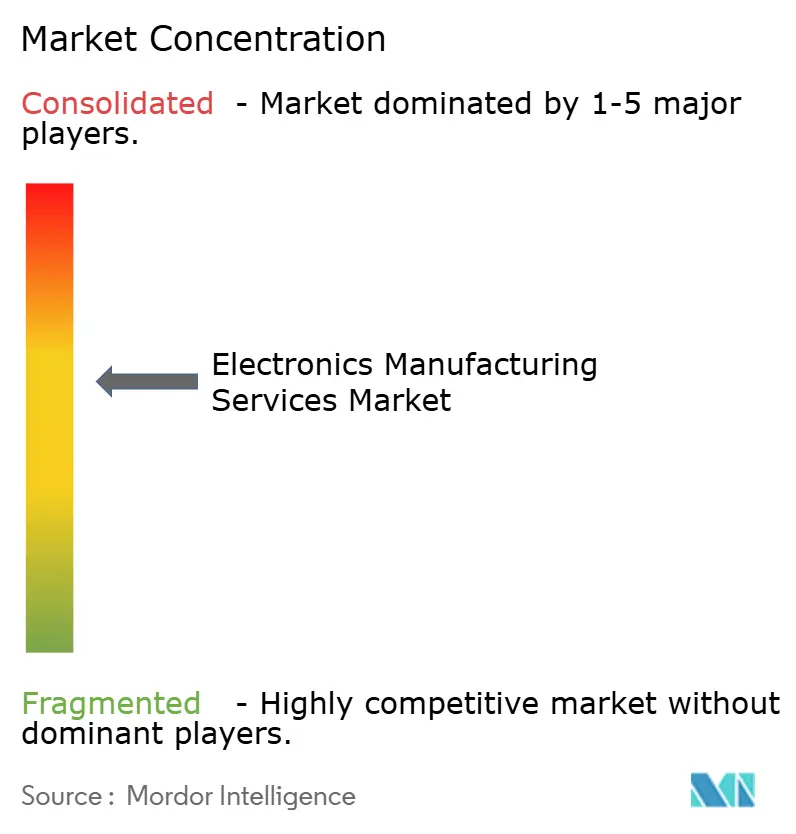
Recent Industry Developments
- May 2025: Sanmina Corporation announced the acquisition of ZT Systems' data-center infrastructure manufacturing business from AMD for USD 2.55 billion.
- May 2025: Jabil Inc. opened its second facility in Gujarat, India, focusing on photonics production.
- March 2025: Foxconn secured exclusive AI server orders for the U.S. Stargate AI project.
- February 2025: Flex opened a 400,000 sq ft Dallas plant dedicated to AI power infrastructure.
Global Electronics Manufacturing Services Market Report Scope
Electronics manufacturing services are used by organizations that design, manufacture, test, distribute, and provide return and repair services for electronic components and assemblies for original equipment manufacturers (OEMs).
The electronics manufacturing services market is segmented by service type (electronics design and engineering, electronics assembly, and electronics manufacturing), application (consumer electronics, automotive, industrial, aerospace and defense, healthcare, IT, and telecom), and geography (North America, Europe, Asia-Pacific, Latin America, and the Middle East and Africa). The market sizes and forecasts are provided in terms of value (USD) for all the above segments.
| Electronics Design and Engineering |
| Prototype and NPI Services |
| PCB Assembly (SMT, Through-Hole) |
| Box-Build / System Integration |
| Testing and Certification |
| After-Market Services (Repair, Reverse Logistics) |
| Contract Manufacturing (CM) |
| Turnkey Manufacturing |
| Original Design Manufacturing (ODM) |
| Private Label Manufacturing |
| Surface-Mount Technology (SMT) |
| Through-Hole and Mixed Technology |
| Advanced Packaging / System-in-Package (SiP) |
| Mobile Devices (Smartphones and Tablets) |
| Consumer Electronics |
| Automotive and EV |
| Industrial and Automation |
| Healthcare / Medical Devices |
| Aerospace and Defense |
| IT and Telecom (5G, Data Centers) |
| Lighting |
| Energy and Utilities (Smart Metering, PV) |
| North America | United States | |
| Canada | ||
| Europe | Germany | |
| United Kingdom | ||
| France | ||
| Italy | ||
| Nordics (Sweden, Norway, Finland, Denmark) | ||
| Rest of Europe | ||
| Asia-Pacific | China | |
| Taiwan | ||
| Japan | ||
| South Korea | ||
| India | ||
| ASEAN | ||
| Rest of Asia-Pacific | ||
| South America | Mexico | |
| Brazil | ||
| Argentina | ||
| Rest of South America | ||
| Middle East and Africa | Middle East | Saudi Arabia |
| United Arab Emirates | ||
| Turkey | ||
| Rest of Middle East | ||
| Africa | South Africa | |
| Rest of Africa | ||
| By Service Type | Electronics Design and Engineering | ||
| Prototype and NPI Services | |||
| PCB Assembly (SMT, Through-Hole) | |||
| Box-Build / System Integration | |||
| Testing and Certification | |||
| After-Market Services (Repair, Reverse Logistics) | |||
| By Business Model | Contract Manufacturing (CM) | ||
| Turnkey Manufacturing | |||
| Original Design Manufacturing (ODM) | |||
| Private Label Manufacturing | |||
| By Manufacturing Process | Surface-Mount Technology (SMT) | ||
| Through-Hole and Mixed Technology | |||
| Advanced Packaging / System-in-Package (SiP) | |||
| By End-use Industry | Mobile Devices (Smartphones and Tablets) | ||
| Consumer Electronics | |||
| Automotive and EV | |||
| Industrial and Automation | |||
| Healthcare / Medical Devices | |||
| Aerospace and Defense | |||
| IT and Telecom (5G, Data Centers) | |||
| Lighting | |||
| Energy and Utilities (Smart Metering, PV) | |||
| By Geography | North America | United States | |
| Canada | |||
| Europe | Germany | ||
| United Kingdom | |||
| France | |||
| Italy | |||
| Nordics (Sweden, Norway, Finland, Denmark) | |||
| Rest of Europe | |||
| Asia-Pacific | China | ||
| Taiwan | |||
| Japan | |||
| South Korea | |||
| India | |||
| ASEAN | |||
| Rest of Asia-Pacific | |||
| South America | Mexico | ||
| Brazil | |||
| Argentina | |||
| Rest of South America | |||
| Middle East and Africa | Middle East | Saudi Arabia | |
| United Arab Emirates | |||
| Turkey | |||
| Rest of Middle East | |||
| Africa | South Africa | ||
| Rest of Africa | |||
Key Questions Answered in the Report
What is the current size of the electronic manufacturing services market?
The market was valued at USD 647.18 billion in 2025 and is projected to reach USD 863.13 billion by 2030.
Which service type dominates revenue?
PCB assembly and box-build services led with 62.4% market share in 2024, driven by high-volume consumer and industrial demand.
Why is Asia-Pacific growing fastest despite already being the largest region?
Capacity diversification into Vietnam and India plus rising regional consumption lifted Asia-Pacific to a 13.1% CAGR even though the region already held 47.3% share in 2024.
How are EV trends influencing EMS providers?
EV power-electronics boards require advanced PCB and packaging skills, boosting automotive and EV segment revenue at a 12.3% CAGR through 2030.
What challenges do EMS firms face with semiconductor pricing?
Component cost swings erode margins because customer contracts often fix prices, forcing providers to adopt hedging and larger buffers to protect profitability.
Page last updated on:
